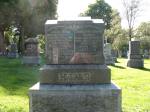 From the collections of the National Maritime Museum, Greenwich, London:
From the collections of the National Maritime Museum, Greenwich, London:
‘A sledge flag embroidered with Sir John Barrow’s motto ‘HOPE ON HOPE EVER’ made by Lady Jane Franklin for Lieutenant Bedford Pim. It was flown from HM sledge John Barrow commanded by Pim when he made contact with the crew of Investigator on 6 April 1853. The flag is made of dark blue ribbed silk with an anchor and motto appliquéd in yellow felt— the details are picked out in gold coloured silk. It has been framed. The Investigator, commanded by Robert McClure, was beset in the ice north of Banks Island, having entered the North-West Passage from the Pacific. After three winters in the Arctic her crew were starving and suffering from scurvy. The arrival of Pim heralded their eventual rescue. He had been sent in charge of a sledge party from HMS Resolute following the recovery of a message from the trapped McClure. This was the first meeting of expeditions entering the North West Passage from opposite ends. Both vessels had been sent to the Arctic to search for the missing ships of Sir John Franklin’s expedition, but Resolute was part of a larger squadron under the overall command of Captain Sir Edward Belcher.’
Sledge flag
Jane Franklin, 1852
National Maritime Museum, Greenwich, London
Object ID AAA0834







